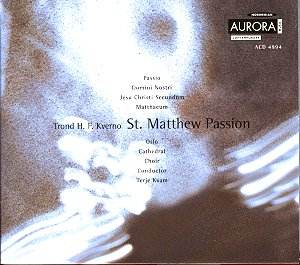I approached Kverno’s St.Matthew Passion with some trepidation,
not knowing what to expect. This is a contemporary setting of the Passion
written by a composer who has been active in Norwegian Liturgical music
for many years. He has contributed many settings of hymns in the Norwegian
Hymnal.
What we have here is a completely new setting of the
Passion, sung entirely in Latin, and inspired not only by the religious
setting, but also influenced by the current social dilemmas.
Choral traditions are very strong in Scandinavia, supported
by close contact with Kodaly whose methods of choral training are well
known. I remember some years ago being totally captivated by a church
choir in Helsinki performing an open concert in their church which was
situated underground. I was extremely impressed by the standards of
singing, and although the Oslo Cathedral Choir is not in Helsinki, the
performance is absolutely superb. The work is written for soloists and
choir alone, no orchestra being present. A Swedish observer was heard
to say: "Very interesting — when did the composer die?"
Trond H. F. Kverno (1945) has written about his St.
Matthew Passion as follows:-
"The modern age needs to erect the Romanesque
crucifix again. It shows the Lamb of God who has been slaughtered
and is worthy of all power and wealth and strength and honour and
praise and blessing - here in the madhouse of our time and for all
eternity. For in the midst of our anxiety about atomic bombs, war,
starvation, cancer and AIDS, in the midst of our total emptiness
and lack of meaning, we hang up the image of the One who gave His
body for the Life of the World: first on the cross and afterwards
when bread is broken and wine is poured in memory of His suffering.
"He who seeks everything the Gothic crucifix
stands for, can turn to the great classical passions: Bach, Handel,
Telemann. They express the horror of the Passion in individual commentaries,
blinded by tears. He who seeks the cultist approach to the secret
of Good Friday has this Passion, in which Willy Abildsnes (b. 1939)
has complemented the story of the Passion itself with responsories
from other parts of the Bible according to the old church code:
the Bible reads itself The origin of the passions. the liturgical
recitation of the story of the Passion of Christ on Good Friday,
was one of the models. However, the part of the evangelist is not
performed by one person but is shared between several voices in
order to reflect the diversity of the gospels and the Bible. The
voice of Christ is in five parts - alluding to the wounds of Our
Lord. Latin has been chosen in the hope that it is not only Norwegian-speaking
people who may need to erect the Romanesque crucifix again — with
its cultist and liturgical dimension." Trond Kverno
This perhaps sets the work into context. Shared voices
for the evangelist and Christ: this is a bit strange at first hearing,
but improves upon familiarity. Added to this is the use of Norwegian
folk tunes throughout the work, but I am sure that this will have a
greater impact upon native Norwegians than those of us who live elsewhere.
The work was first performed in an amputated version
when the Norwegian Association of Church Musicians hosted the fourteenth
meeting of Nordic church musicians in Oslo in June 1986. The Passion
narrative was read in Norwegian by Nils Ole Oftebro while the responsories,
or commentaries, were sung and the entire piece was broadcast live on
Norwegian radio.
The work was then recorded and it is this performance
which we are covering here. The singers are all first rate, with unusually
for a work from this source, the soloists being names likely to be known
to us. I bet that if the text had been written in Norwegian we would
have had quite a different outcome.
The choir is superb, and there is not a weak soloist
anywhere in sight. I was quite moved by this Passion, and being used
to the Bach and Handel works, I appreciated similar emotions at the
big points so to speak. The recording could not be bettered, being clear
and truthful, with just enough depth to prevent it from sounding studio
bound. The conductor, Terje Kvam, the original conductor of the piece
does his work admirably, and inspires his forces to give an extremely
moving performance. Once you have got past the sound picture, I can’t
imagine anyone not liking this work, and I do urge you to try it.
John Phillips
